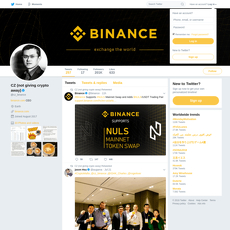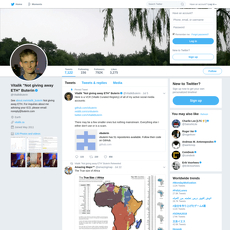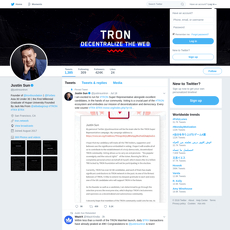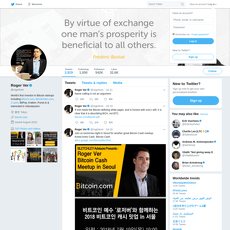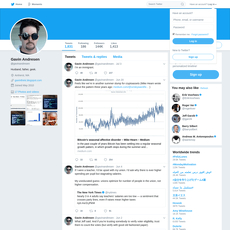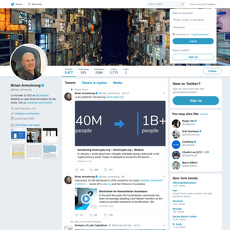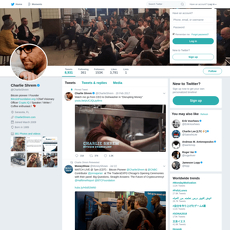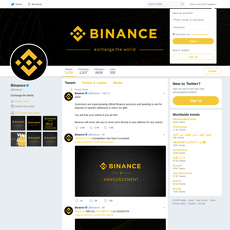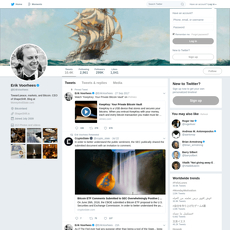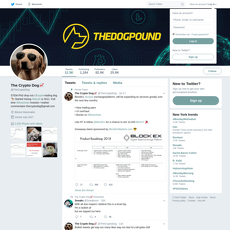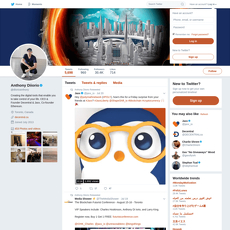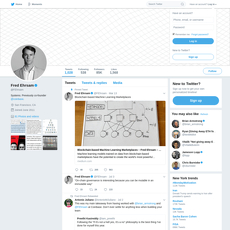Nicolas Cary Review
Nicolas Cary
twitter.com
Nicolas Cary Review Guide: Everything You Need to Know + FAQ
Ever wondered if following @niccary on X is actually worth your time—or just another follow that clutters your feed?
I keep tabs on the people who genuinely move crypto forward. In this guide, I’ll show you what you can learn from Nicolas Cary, how to get value from his posts, and where to find reliable extras—so you don’t waste hours scrolling.
If you want a real-world perspective from a co-founder of Blockchain.com, with practical takeaways and straight answers to common questions, you’re in the right place.
There’s a problem: crypto Twitter is noisy
Let’s be honest—your feed is crowded with hype threads, recycled memes, and hot takes that don’t age well. Separating signal from fluff is hard, and figuring out whether a specific voice is worth your attention is even harder.
“More followers doesn’t equal more signal. Consistency, clarity, and skin in the game do.”
- Hype vs. substance: Viral threads often reward drama over accuracy. An MIT study found that false news spreads faster on social platforms than the truth—especially in finance and politics.
- Shilling and conflicts: Opaque promotions and low-effort endorsements waste your time and can lead to bad decisions. Chainalysis reports consistently show social-platform scams as a major attack vector.
- Time sink: It’s tough to know which posts deserve attention and which can be safely ignored without missing anything important.
- Credential confusion: Is the person building real products—or just commentating from the sidelines?
The solution I promise you here
I’ll break down who Nicolas Cary is, what he talks about, how to read his posts like a pro, and how to use his insights without getting pulled into the hype spiral. I’ll also answer the common questions people ask and point you to credible resources in one place.
Quick wins you’ll get right away
- Fast context: What to expect from @niccary at a glance—so you know whether to follow now or skip.
- My review checklist: A simple framework you can reuse to judge any crypto personality for credibility and usefulness.
- How he stacks up: A practical, no-hype snapshot focused on real-world building and leadership—not trading calls.
- Practical following tips: Turn down the noise with Lists, filters, and a lightweight tracking setup that surfaces the good stuff.
- Action plan: A quick, repeatable 10-minute routine to scan his updates without drowning your feed.
How to read his posts like a pro (and save time)
- Use smart filters: In X search, try
from:niccary filter:linksfor posts with sources;from:niccary -repliesfor signal-heavy updates. - Three-pass method:
- Skim for themes (product launches, regulation, hiring, security).
- Scan linked sources or threads for specifics (dates, partners, features).
- Save high-value posts to a List or bookmarks for quick reference.
- Watch language cues: Phrases like “shipping,” “uptime,” “security,” “hiring,” and “compliance” usually signal operator-level insights over speculation.
- Cross-check important claims: Use official press pages, company blogs, or reputable analytics sources before you act.
What this guide isn’t
This isn’t about altcoin picks or aggressive price calls. It’s about learning from someone who operates in the industry—so you get context that stays useful long after the hype cycle fades.
Why this matters right now
As crypto matures, the edge isn’t in chasing every swing—it’s in understanding how real teams build, ship, and navigate policy and security. That understanding starts with following the right people, the right way.
Ready for the quick snapshot? Up next: a tight profile that shows who Nicolas Cary is and what you can expect from his feed—so you can decide in 30 seconds whether he earns a spot on your List. Want that rapid profile?
Who is Nicolas Cary? The quick profile
Nicolas Cary is the co-founder and Vice Chairman of Blockchain.com, one of the longest-running companies in crypto. He’s a founder-operator who’s been building through multiple market cycles, speaking publicly about Bitcoin adoption, responsible product design, and the reality of bringing crypto to mainstream users.
He sits at the intersection of product, policy, and growth—close enough to the code and the customers to share useful lessons, and seasoned enough to understand the trade-offs that actually matter.
Why his voice matters
Plenty of accounts talk about crypto. Far fewer have shipped wallets, run exchange infrastructure, and navigated licensing and compliance across jurisdictions. That’s where Cary’s signal comes from: the practical view of someone who has had to make real decisions with real users and regulators watching.
- Built through volatility: insights shaped by bull runs and heavy drawdowns, when scaling, uptime, and risk controls get tested hardest.
- Product reality: wallet architecture, custody considerations, and trade-offs between UX and security—where theory meets production.
- Regulatory literacy: KYC/AML expectations, market-by-market requirements, and how policy changes affect release calendars and hiring.
“Build for the next decade, not the next candle.”
There’s also a trust element here. Independent research regularly shows people put more stock in operators and technical leaders than in celebrity influencers. For example, the Edelman Trust Barometer has consistently found experts and business leaders rank highly for credibility in complex topics.
What you’ll see on twitter.com/niccary
His feed skews toward the builder’s side of crypto—expect substance over sizzle.
- Product updates: wallet security improvements, performance upgrades, exchange/feature rollouts, and notes on reliability during busy market moments.
- Hiring signals: roles in compliance, security engineering, payments, or institutional coverage—useful if you track where serious teams are investing.
- Policy and market structure: commentary on frameworks like MiCA, licensing paths, and what “being regulated” actually requires day to day.
- Conference takeaways: field notes from stages like Consensus, Money20/20, WEF, or regional forums—what builders and policymakers are really debating.
- Macro and adoption: balanced views on Bitcoin, stablecoin utility, and the infrastructure milestones that move the needle for mainstream users.
What you won’t get: aggressive trading calls, meme-chasing, or altcoin shills. If you want a coverage map of the industry rather than a ticker-by-ticker commentary, this is a fit.
Where he stands out
I pay attention to a few patterns in his updates because they tend to predict where the space is heading:
- Operator mindset: threads that explain why a product decision was made, not just that it shipped—risk, user feedback, and compliance all show up in the reasoning.
- Long-term bias: prioritizing reliability, security posture, and brand trust over short-term engagement—especially visible during market stress.
- Compliance fluency: straight talk on KYC/AML and licensing rather than hand-waving—useful if you care about products that survive audits and regulators.
- People and process: hiring notes that highlight the kinds of skills mission-critical teams actually need next (fraud, infra, payments, incident response).
- User safety lens: reminders to verify announcements, check status pages, and practice basics like 2FA and phishing awareness—rarely glamorous, always important.
Pro tip: when he posts hiring or policy threads, read them as roadmaps. Teams hire and comment where their roadmap is moving. That’s often a cleaner signal than any headline.
Sample themes you’ll likely catch
- Security-first product notes: for example, emphasizing backup hygiene, keys/custody choices, and iterative hardening over one-shot “perfect security.”
- Regulatory milestones: acknowledging licensing steps or regional permissions, plus what that unlocks for customers in those markets.
- Scalability and reliability: stress on uptime during spikes, status transparency, and resilience planning—things users only notice when they break.
- Industry stewardship: support for education initiatives, responsible adoption, and collaboration with policymakers to keep innovation on the rails.
It’s a steady feed—less adrenaline, more architecture. If you’re building, leading teams, or just care about how crypto products actually reach millions of people, you’ll feel at home here.
So the real question: does that mix make him worth your follow if you want sharper crypto insights without the noise? Let’s look at the kind of learning you can expect and who gets the most value next.
Is Nicolas Cary worth following for crypto insights?
If you care about the real machinery of crypto—wallets, custody, scaling decisions, and how teams ship under pressure—yes, he’s worth your attention. If you’re hoping for daily altcoin calls, you won’t find that here, and that’s exactly why his feed is useful. It’s a builder’s lens on what actually lasts.
“In crypto, volatility is loud; reliability whispers.”
What you’ll actually learn
I use his posts as a window into how mature crypto companies think and operate. Here’s the kind of signal I watch for:
- Product shipping cadence: When he highlights feature rollouts or infrastructure upgrades, it tells you how serious teams sequence priorities, manage risk, and harden reliability before peak traffic.
- Communication under stress: During market swings or network congestion, watch his tone. You’ll see how seasoned operators calm users, set expectations, and share timelines. That’s a playbook you can reuse.
- Hiring = roadmap: If he flags new roles in custody, compliance, or SRE, treat it as a preview of where investment and demand are heading. Headcount is one of the cleanest forward-looking signals.
- Regulatory posture: He often comments on policy moments and industry standards. It helps you separate performative outrage from practical compliance that keeps platforms live and users protected.
- Macro narratives teams actually track: Not the meme-of-the-day, but the structural shifts—onramps, liquidity, developer incentives, consumer UX—where adoption either compounds or stalls.
There’s a useful reason to prefer operator voices like his. Research from MIT on X/Twitter found that false news spreads faster than truth because it’s more novel and emotional (Vosoughi et al., Science). Following builders who publish verifiable updates—shipping notes, hiring, compliance statements—cuts through that noise. It’s less dopamine, more durable knowledge.
Who benefits most from following him
- Founders and PMs: If you’re shipping product, his posts give you templates for changelogs, incident comms, and stakeholder updates that don’t burn trust.
- Security-minded users: You’ll pick up how reputable firms approach custody, KYC/AML, and uptime. Boring to some—critical if you actually keep assets in crypto.
- Operators and team leads: Hiring and org structure hints help you see what “good” looks like at scale: what roles matter, when to add them, and how to communicate why.
- Newcomers: You won’t be thrown into trader-speak. It’s a safer starting point to understand the industry’s backbone before you chase anything flashy.
One more data point: according to the 2024 Edelman Trust Barometer, business leaders remain more trusted than media in many markets. In crypto, that trust gap is amplified. Hearing directly from an operator at a longstanding platform reduces the second-hand rumor mill that fuels bad decisions.
How to read his feed like a product manager
When I scroll, I’m not just “liking” updates—I’m decoding them. Try this lens:
- Translate posts into milestones: A hiring thread for SREs isn’t just hiring; it’s a signal that load and uptime requirements are rising. Expect performance investments and traffic growth.
- Tag risks and mitigations: If he references policy changes or exchange requirements, note what risks are being acknowledged and how the team is reducing them.
- Build your own timeline: Log big moments (feature launches, policy commentary, market spikes) and compare the tone and speed of communication across each. Patterns teach you how pros operate.
- Extract reusable templates: Screenshots of clean incident updates, roadmap statements, or hiring criteria? Save them. Professional phrasing under pressure is a competitive advantage.
Set the right expectations
- Not financial advice: Treat his feed as a window into decision-making, not a trading signal. Operators optimize for resilience; traders optimize for movement. Different jobs.
- Less sizzle, more scaffolding: You’ll get the “how” and “why” behind shipping and compliance, not moon-math.
- Verify important announcements: Always cross-check links with official pages and status portals. Trust, but verify—every time.
Pair it with a few research-heavy accounts
To get the full picture, I layer his operator view with data and security voices:
- @MessariCrypto for structured research and sector maps
- @glassnode for on-chain activity and market structure
- @chainalysis for compliance trends and illicit flow analytics
- @trailofbits for security insights and real-world engineering lessons
- @jchervinsky for policy and regulatory analysis
This combo keeps your feed grounded: one stream tells you what credible teams are doing; the others quantify market health, risk, and policy pressure.
A quick sample of what signals look like in practice
- “We’re hiring for custody and compliance” → Expect institutional features, audits, and stricter onboarding. That’s a growth-and-maturity signal.
- “Conference notes with policy takeaways” → Track shifts in regulation or standards that could change how retail and institutions access crypto.
- “Product upgrade focused on performance” → Translation: the team is optimizing for peak traffic. Watch for smoother experiences during volatility.
If you want the story behind those signals—how they connect to a company that’s been through multiple cycles and still ships—curious what that looks like from the inside of a major platform you’ve probably used at least once?
Nicolas Cary and Blockchain.com: the essentials
I track builders who actually ship, and Nicolas Cary sits in that camp. His role in scaling Blockchain.com from the early Bitcoin explorer-and-wallet days into a broader, regulated platform tells you a lot about what he optimizes for: real users, uptime during chaos, and trust that isn’t just marketing.
“In crypto, trust is earned in the quiet months and tested in the crazy ones.”
Key milestones and focus areas
Here’s what stands out when I look at his body of work and the platform’s trajectory:
- From block explorer to mass-market wallet: Blockchain.com became one of the most recognized wallet brands early on. The non-custodial roots mattered—users holding their own keys is a very different mindset than speculative trading-only apps.
- Exchange and brokerage features: Over time, buying/selling, swaps, and later exchange functionality were added. That shifted the company from “wallet utility” to a more complete retail stack, with the typical trade-off: more features require more compliance.
- Institutional services: An OTC/Institutional arm emerged as a serious business line, signaling a focus on larger ticket flow, liquidity, and risk management. When a company builds both retail and institutional, you see decisions geared toward resilience over hype cycles.
- Reliability during peak traffic: Big market moves are the true stress tests. The priority I’ve seen emphasized is stability and transparent status updates when the mempool is clogged or volumes surge.
Funding rounds and major partnerships over the years reinforced that long-game approach. While valuations come and go with the market, the consistent push has been product breadth plus operational maturity.
Trust, safety, and reputation
Watching Cary’s updates and the company’s public stance, a few themes repeat—and they’re the ones you want from a platform at scale:
- Security-first posture: Non-custodial options keep keys in the user’s hands. Custodial features (where provided) lean on standard protections like 2FA, anti-phishing controls, and withdrawal checks. It’s not flashy, but boring is beautiful when it comes to user funds.
- KYC/AML in regulated markets: Expect full onboarding flows where required. For users who value speed over verification, this can feel slow. For those who value longevity, it’s a green flag. Independent research (e.g., annual Chainalysis crypto crime reports) consistently shows that stricter monitoring and compliance reduce illicit flows at scale.
- Clear incident communication: During the 2022 contagion (e.g., industry exposure to Three Arrows Capital), the company publicly addressed risk and made operational changes. That’s the behavior I look for under pressure—own the problem, explain the plan, and keep users informed.
- Status and service transparency: Large platforms live and die by their status comms. When I see a team point users to official notices instead of burying updates, I mark that as a reliability cue.
What this looks like in practice
- Volatility windows: Think ETF approval days, halving weeks, or unexpected policy headlines. If you’ve been through a few, you know which platforms wobble. Cary’s messaging tends to be “keep the pipes open, keep users informed, protect the edges.”
- Feature rollout patterns: Wallet improvements, exchange tweaks, and institutional add-ons usually ship with a compliance lens. It’s not the fastest possible path—but it’s the path that keeps large user bases intact.
- Cross-cycle behavior: In bull runs, it’s easy to overpromise. The stronger platforms play the long game: more guardrails, fewer headline-grabbing shortcuts.
Balanced view: strengths and trade-offs
- Strengths: brand longevity, broad distribution, regulated-market experience, and a track record of handling traffic spikes without theatrics.
- Trade-offs: compliance friction in certain flows, slower shipping than a two-person startup, and the usual “big target” reality—scams try to spoof large brands, so users must be vigilant.
That trade-off is normal. If you want massive reach and safety rails, you accept some process. If you want bleeding-edge experimentation, you accept more risk. Cary’s work sits firmly in the “reliable first” camp.
How I personally use platforms like this safely
- Control your keys for long-term holds: If the wallet offers non-custodial, use it. Back up your seed phrase offline. No screenshots. No cloud notes. Ever.
- Lock down your account: 2FA via an authenticator app, withdrawal address allow-list, anti-phishing codes in email where available.
- Verify the source: Only use the official domain (blockchain.com). Bookmark it. Ignore “support” DMs and Telegram invites.
- Check the official status page before big moves: If the market is wild, glance at the platform status first. Saves you headaches and failed transactions.
- Read updates end-to-end: When the company posts about policy or upgrades, read the full note. Screenshots miss nuance that can affect your funds.
Signals I look for in Cary’s updates
- Security or wallet changes: Anything touching key management, recovery, fee logic, or transaction reliability gets my full attention.
- Institutional growth notes: Hiring, partnerships, or liquidity updates hint at market depth and risk posture.
- Regulatory positioning: Approvals, registrations, or compliance enhancements can forecast which features will stick around in key regions.
- Traffic and uptime commentary: If he talks about scale, I assume stress testing is happening behind the scenes.
A quick reality check
Big brand ≠ zero risk. The right mindset is “trust, then verify.” I like platforms that act like adults: explain changes, handle crises with receipts, and make boring, consistent choices about user safety. Cary’s track record is aligned with that. And when something does go wrong, the question is simple: do they talk straight and fix it fast?
If you’ve ever wondered how I separate the real builders from the noise, here’s your moment—want my exact checklist for judging credibility, transparency, and usefulness (the same one I use on founders like Cary)? That’s next.
My review checklist: how I assess a crypto personality
I’ve learned the hard way that who you follow shapes how you think—and the trades you don’t take are often the ones that save you. So I run every crypto voice through the same, simple checklist. It keeps my feed clean, my attention sharp, and my risk low.
“Trust is built in drops and lost in buckets.”
Here’s exactly what I look for, what I avoid, and a fast test you can run on any account in under 10 minutes.
Signals of credibility I look for
- Clear, verifiable track record. Roles, products, and timelines you can confirm. Good signs: links to official org pages, product changelogs, or reputable press. If someone claims “security expert,” I want to see the receipts—roles, real teams, shipped work.
- Evidence over opinions. Posts that link to primary sources: policy docs, on-chain data, postmortems, and hiring pages. This matters because sensational claims spread faster than facts. A large study in Science found false stories on Twitter spread “farther, faster, deeper” than true ones (Vosoughi et al., 2018). People who link sources help you anchor to reality.
- Responsible risk language. No “this will 10x by Friday.” Instead: context, scenarios, and trade-offs. I watch for phrases like “not financial advice,” but more importantly, a sober tone about volatility, custody risk, and regulation.
- Consistency across market cycles. Same principles in bull and bear. In bear markets, credible builders talk about uptime, shipping, and user support—not engagement farming.
- Transparency when things break. Owning issues and linking to incident reports or status pages is a green flag. A real builder doesn’t hide from hard days.
- Quality of network. Look at who engages with them—operators, researchers, policy folks—versus anonymous hype accounts. Bot-heavy replies are a caution sign (see research on bot amplification, e.g., Varol et al., 2017).
- Builder breadcrumbs. Hiring notes for critical roles, product milestones, and thoughtful takes on compliance and security. That’s the boring-but-real stuff that compounds knowledge over time.
Red flags I avoid
- Aggressive price calls and “guarantees.” If someone throws out targets without risk framing, I’m out. Research documents coordinated “pump” behavior in crypto social channels (Li, Shin, Wang, 2018).
- Opaque promotions or undisclosed ads. If there’s a referral link, I expect clear disclosure. The FTC’s endorsement rules require it (FTC Guidance). No #ad or clarity? Big warning sign.
- Screenshot claims without links. If it’s important, link it. No links = no trust.
- Delete-and-rewrite behavior. Wiping wrong calls and pretending they never happened is a pattern. Everyone gets things wrong; the good ones own it.
- Giveaways that require deposits or wallet connections. Classic scam pattern. Hard pass.
- Relentless pivoting. Today it’s NFTs, tomorrow it’s AI agents, the next day memecoins—without any thread of accountability. Curiosity is good; hopping to whatever pumps isn’t.
- Engagement bait. “Reply ‘YES’ for an airdrop,” “Only 100 spots left,” “Retweet to win.” This isn’t how serious people communicate.
If three or more of those red flags show up within a few scrolls, I keep it moving.
The 10-minute audit (try this on any account)
- Bio check: Are affiliations clear? Is there a link to an org, LinkedIn, or past work?
- Source count: Scroll 30 recent posts. How many link to primary sources (docs, data, official sites)? Quick trick: use X search “from:username filter:links”.
- Risk language: Do they frame uncertainty, or only talk in absolutes?
- Bear market behavior: Jump to their posts during past downturns. Were they calm and constructive, or pushing Hail Mary trades?
- Engagement quality: Who replies? Builders and researchers, or bots and burner accounts?
- Receipts: For product or policy claims, can you click through to a status page, a changelog, or an official filing?
- Self-check: Notice your own FOMO. Simple “accuracy nudges” reduce bad shares and bad decisions (Pennycook et al., 2020). If a post spikes your adrenaline, pause.
How Nicolas Cary stacks up against this checklist
Strengths: strong builder credentials, steady tone, and product-first updates. You’ll mostly see operational signals—shipping notes, hiring for key roles, security/compliance commentary, and policy takes. When markets get choppy, the emphasis shifts to reliability, uptime, and user support rather than hot takes. That’s exactly what I want from an operator.
What you won’t get: meme pumps, aggressive price calls, or engagement bait. If you’re after “next 100x” threads, this isn’t that feed. If you want durable knowledge and a view into how established teams make decisions, it’s a good fit.
A quick gut-check I use before following
- Can I learn something actionable in 5 minutes a week? If yes, follow. If not, List them or pass.
- Would I forward their post to a colleague? If I’d be embarrassed to share it, it doesn’t get space in my feed.
- Do they make me calmer, smarter, and more patient? If the answer is “they make me chase,” that’s a clue.
Want the exact links and a simple setup to keep your feed signal-heavy without muting the good stuff? I’ll share the starter list and my “follow smart” system next—one tweak takes 60 seconds and saves hours of scrolling. Ready?
Helpful links, interviews, and how to follow smart
Let’s keep this simple and useful. You want the signal, not another noisy feed. Here’s exactly how I would follow @niccary to get real insight without losing your day.
Start here
Follow his official X account: https://twitter.com/niccary. Then do a quick scan that actually teaches you something:
- Check the pinned post and the latest 10–20 posts to see current priorities (hiring, policy, product rollouts).
- Replay big moments to understand how he communicates under pressure. Search his posts around:
- Nov 2022 (exchange blow-ups, liquidity stress)
- Mar 2023 (banking stress and stablecoin volatility)
- Jan 10–12, 2024 (spot Bitcoin ETF approvals)
- April 2024 (Bitcoin halving)
- Use X advanced search to fast-filter what matters. Paste these into the search bar on X:
from:niccary since:2024-01-01 until:2024-01-20
(policy OR regulation OR compliance) from:niccary min_faves:50
from:niccary filter:replies
from:niccary filter:links url:blockchain.com
Why this works: you’ll see how he addresses policy, where he links official updates, and which replies add context beyond headlines.
Use these to cross-check claims you see on social feeds. There’s good reason to do it: a well-cited study in Science found false news spreads faster than true news on social platforms (Vosoughi, Roy, Aral, 2018). Long-form interviews and official posts are your filter for accuracy when sentiment gets loud.
Set up a clean, signal-first feed
- Create a custom X List called “Crypto Builders.” Add @niccary and 5–10 operator voices. Open this list when you want context, not memes.
- Turn on notifications for him only during major market weeks (policy votes, Bitcoin halving, ETF filings). Constant pings hurt focus; research shows interruptions increase errors and stress (Mark, Gudith, Klocke, CHI 2008).
- Mute fluff terms if needed (e.g., “giveaway”, “airdrops”) so you see product, policy, and security first.
Weekly 10-minute routine
- Open your Builders list; read the last 7–10 posts from @niccary.
- Run this quick filter for high-signal posts:
from:niccary (hiring OR shipped OR launch OR update OR “we’re hiring”)
from:niccary (security OR incident OR outage OR status) - Open any linked blog or official updates in new tabs. Save the best ones to bookmarks or a notes doc with one-line takeaways.
Power-user shortcuts
- Find official links fast:from:niccary filter:links url:blockchain.com to catch company posts and product notes.
- Surface context-rich replies:from:niccary filter:replies min_faves:10 to see where he adds nuance under headlines.
- Time-bound queries:from:niccary since:2023-03-01 until:2023-03-31 to analyze how he handled the March 2023 banking events.
- Skim threads only:from:niccary filter:threads for longer breakdowns.
What to skip (saves time)
- Quote-tweet pile-ons without links to original sources. Go to the source or an official blog instead.
- Screenshot threads that don’t include a URL. If it matters, there’s a link.
- Out-of-context charts without methodology. If the datapoint is real, it’s usually cited in long-form resources or official releases.
Bookmark this mini-checklist
- Use your “Crypto Builders” list; keep it under 15 accounts.
- Notifications only during major events (policy, ETF, halving, security incidents).
- Search operators weekly:
from:niccary filter:links url:blockchain.com
from:niccary (policy OR regulation) min_faves:50
Curious whether he shares investment advice, how Blockchain.com fits into crypto’s history, or the fastest way to verify announcements? I’ve got quick answers next—want the shortlist that saves you hours?
FAQ: common questions about Nicolas Cary
Here’s a fast, friendly FAQ based on what people actually search for and ask me. Short answers, smart tactics, and a few research-backed tips to keep you informed without getting lost in the feed.
Rapid answers to popular questions
Who is Nicolas Cary?
Co-founder and Vice Chairman of Blockchain.com, and an operator voice on X. If you want the builder’s angle on crypto, he’s a practical follow. Here’s his profile: @niccary.
What does he tweet about?
Company updates, product and hiring notes, policy and regulation, security, and on-the-ground takeaways from conferences. Expect threads that read like a builder’s checklist—e.g., shipping notes, open roles in engineering/compliance, and key policy signals—not trading calls.
Does he share investment advice or price targets?
Generally no. The tone is operator-forward (product, risk, regulation). Treat anything market-adjacent as context, not a signal to buy or sell.
How does Blockchain.com fit into crypto’s history?
It’s one of crypto’s longest-running companies, initially recognized for its Bitcoin wallet and expanding into trading and institutional services. That longevity gives useful perspective on security, uptime, and compliance during high-volatility moments.
Is the account legit? How do I avoid imposters?
Confirm the handle is @niccary and cross-check anything important with official pages on Blockchain.com. Be cautious with DMs and “giveaways.” Research shows false content spreads faster than true content on social platforms—click through and verify before you act (Science, 2018).
How do I follow him without getting overwhelmed?
Create a small X List of builder accounts (include @niccary), mute retweets if you need signal, and only turn on notifications for major events. Here’s X’s quick guide to Lists: help.twitter.com/en/using-twitter/twitter-lists. Also, schedule short check-ins—limiting social media windows improves focus and well-being (UPenn randomized study).
Can I use his posts to trade?
That’s not the best use. Think of his feed as context about building and policy. Social feeds can nudge herd behavior, and knee-jerk reactions to headlines are a common source of mistakes. If you make market decisions, treat X as one of many inputs and verify with primary sources and data.
What’s the best way to extract value from his threads?
Look for patterns: hiring (which teams are growing), regulatory focus (what jurisdictions matter now), and product signals (security and infrastructure priorities). Save notable threads; compare them with company press or product pages. This turns passive scrolling into a living research notebook.
How often does he post?
It varies by market and events. That’s another reason Lists and periodic check-ins beat constant scrolling. Most people now get some news via social, but not frequently—and skepticism is healthy (Pew Research).
Quick pro move: always click into the original thread. Screenshots skip nuance and are easy to manipulate.
Action tips
- Verify big announcements via official sites and company posts before you act or share.
- Read full threads, not screen-grabbed snippets, to catch context and caveats.
- Use a dedicated X List for builders and policy voices; mute retweets if your feed gets noisy.
- Timebox your checks (for example, 10–15 minutes, 2–3 times a week) to reduce FOMO and mental fatigue.
- Pair with long-form resources (interviews, talks, company posts) so you understand the “why” behind short updates.
Final take
If you want an operator’s view of crypto—less hype, more substance—following @niccary is a smart move. Set up a clean follow strategy, verify important news at the source, and keep a small library of long-form links. Use this approach, and your feed turns into a real learning tool you can trust.
CryptoLinks.com does not endorse, promote, or associate with Twitter accounts that offer or imply unrealistic returns through potentially unethical practices. Our mission remains to guide the community toward safe, informed, and ethical participation in the cryptocurrency space. We urge our readers and the wider crypto community to remain vigilant, to conduct thorough research, and to always consider the broader implications of their investment choices.


